Main Street of Malmo: the abandoned bank windows stand open
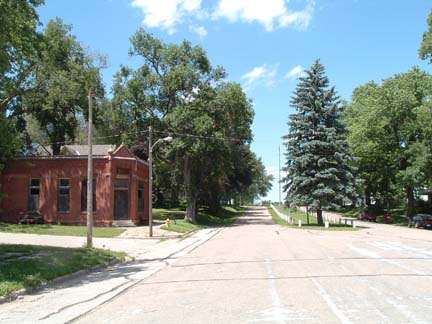
I admit to being charmed by very small, out-of-the-way villages and their churches, particularly when they are Swedish. Few towns combine these elements as strikingly as Malmo in west central Saunders County. Many such communities chose names for themselves which pointed to Swedish roots, but Malmo simply selected the name of a well-known city in Sweden for its own. The Augustana historian chides the people of Malmo for holding too long to the Swedish language. But they were not alone in imagining that their culture would endure intact. It was merely the case that these things were able to endure here longer than anywhere else, some might say they preserved some characteristics of the immigration days which had disappeared even in the homeland!
It may seem surprising that the Nebraska Conference of the Augustana Synod held its charter meeting at the Edensburg church of Malmo. Or that the national annual meeting of the Evangelical Lutheran Mission Synod met there in the Bethesda Mission church. There is much history associated with Malmo and we are fortunate to have the records of both synods from which to draw.
Since it was the charter meeting of the Augustana Nebraska Conference that took place here, we must imagine the time before that body even existed. Nebraska was then a mission field, and the Kansas conference was charged with conducting missions there. Swedish believers were growing in numbers and eager to form churches but pastors were very few. Those in Malmo relied on visits from pioneer S.G. Larson, who had himself been the first Augustana pastor in Nebraska, sent there from Illinois. He left Immanuel in Omaha to serve the three Saunders County congregations of Mead, Swedeburg and Malmo.

Pioneer Pastor and Mrs. S.G. Larson
Sandahl gives the specifics of separation from the Kansas Conference. At one point the Nebraskans were so disillusioned with their southern brothers that they requested alliance with Iowa instead! At last they received their independent charter, but Sandahl observes that the event warranted no mention in the Kansas minutes!
In those days, the Lindsborg Kansas experiment with the so-called "pure congregations", an effort to restrict membership to converted believers only, had been abandoned by pastor O. Olsson. At Swede Home, Augustana auditors from Kansas checked up on pastor A.N. Sweders who was applying this practice there. Some of the immigrant revival people wanted this arrangement, stemming directly from their distaste at having the whole population show up for communion in Sweden. There they found themselves at the altar with the unsaved, the unwashed and the unabstaining whose civic obligation it was to commune at least once a year. Those who claimed the opportunity of religious freedom in America to change this situation found themselves at odds with the centralized authority of Augustana, whose leaders took a stand for open membership. The result was schism; in Lindsborg, at Swede Home, in the three Saunders County churches and in many other places. The effects of this problem are clear in the following lists of early members of Edensburg, Malmo (Augustana) and Bethesda, Malmo (Mission):
J. Frostrom...............................A. Peterson
A. Pollack..................................A. Pollack
J. Bredenberg.............................J. Pollack
J. Larson...................................C. Nordahl
O. Bostrom...............................P. Bostrom
L. Bruce......................................P. Bruce
A. Blomberg..............................L. Isakson
In some cases individuals who had been leaders in the Augustana group subsequently became leaders in the Mission group. Certainly the division affected families as well. The Bethesda history mentions visits from Oakland by Mission pastors O.M. Nyman and John Peterson. Nearby Mission pastor A. Hallner of Swedeburg would surely have been a catalyst for the formation of the Mission congregation. Augustana policy had excluded him from the pulpit there, and motivated those loyal to him to separate. S.G. Larson preached at Malmo only once a month. On the other Sundays there were opportunities for other points of view to be aired. Larson himself was a local homesteader and not of the stripe of eastern Augustana "centralists."
The Bethesda history cites the issue of regenerate membership as central. It does not mention Waldenström. It pointedly states that the congregation's constitution embraced the unaltered Augsburg Confession and aligned itself with the Lutheran Mission Synod. In these ways, it seems to be standing very close to the position of Augustana except for the membership issue.
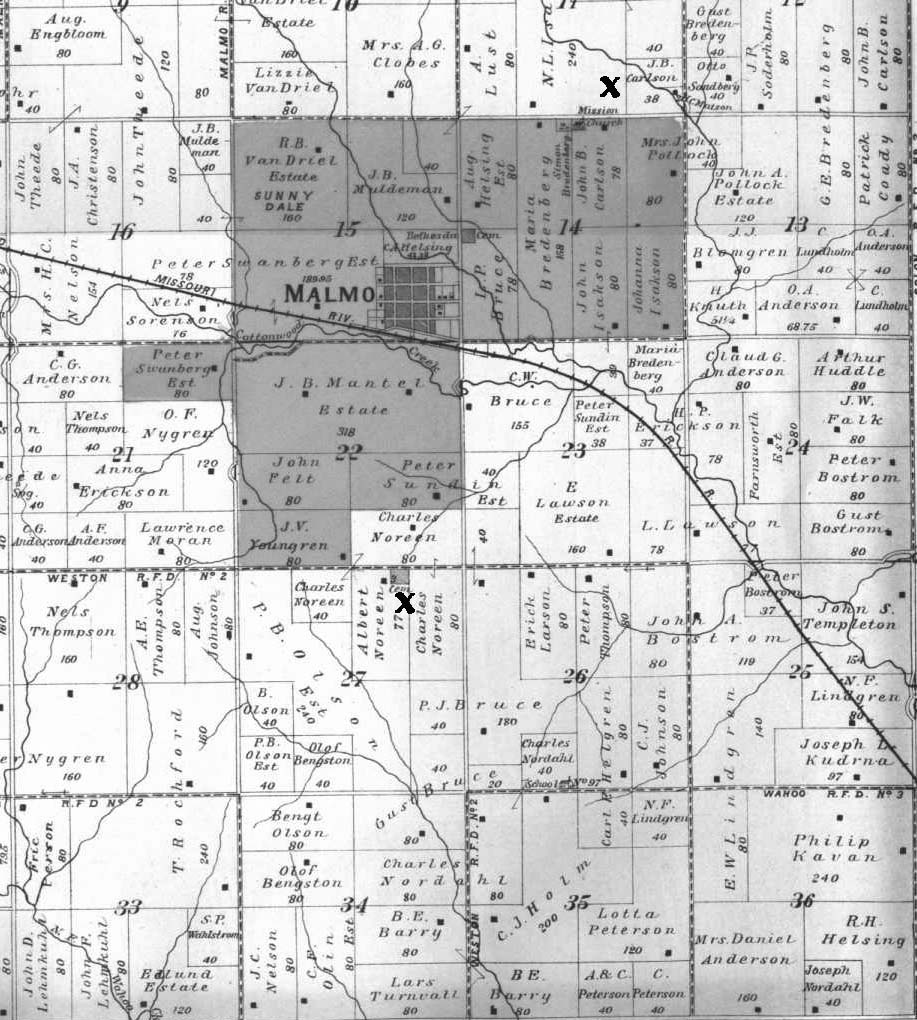
"X"s mark the spots of the Edensburg cemetery and the first Bethesda church
Note the many member's names on nearby farms
The book, "Past and Present of Saunders County", available on the Nebraska Genweb site, contains the following paragraph naming some of the immigrants appearing above and explaining the presence of the non -Scandinavian name "Bruce":
L. Isaacson, later a grain and stock dealer, was the first to settle in the vicinity of Malmo. He was from Kristianstad Lan, having emigrated to this country in 1868, and settled or homesteaded in the spring of the next year. Andrew Blomberg came two weeks later from Omaha with a colony of Swedes from Dalcadia. Following is a list of these settlers around Malmo: L. T. Bruce, J. Bredenburg, A. Helsing, P. Blomberg, A. Rosenberg, J. Nelson, J. Larson, L. Ljungstrom, Bengt Olson and three sons, Jacob and John Frostrum, L. Lundberg, O. Nelson, P. Nelson, P. Pherson, Per Olson, J. Erickson, H. Hokanson, M. Erickson, M. Hokanson, ? Eliason, Olof Bostrum. The Bruces were descendants of the famous Scottish chieftain, Robert Bruce, who had fled Scotland and settled in Sweden to escape the persecution of the English throne.
(At nearby Weston, a J. Bruse [sic] is listed among the charter members of the Swedish congregation there; a Baptist group)

Isaacson was the first settler; belonged first to Edensburg, then Bethesda
Concerning Isaacson, Sandahl notes that in the original Augustana congregation he conducted regular Sunday School classes in his home. This points to a "conventicle" style of meeting typical of the revival movement in Sweden, a practice which ultimately lead to the separation of the Mission people from the state church. Little surprise then, that upon the formation of a Mission church in Malmo, Isaacson should be among its numbers. It is also noted that many immigrants to Malmo were from the province of Dalarna. The Greenwalls were also from this province, which may add to my fondness for this little Nebraska enclave.
Of the Malmo people, Sandahl also observes: "Religiously these, as so many of the early settlers in Nebraska, were of the pietistic type. They assembled together in their sod houses and dugouts for mutual edification by reading from the devotional books of Rosenius, Ahlberg, and others, and singing, without instrument, from Svenska Psalmboken and other Swedish collections of hymns. Rev. S.G. Larson, the pioneer pastor, paid them occasional visits. These visits were looked upon as spiritual feasts. The whole colony attended these services. In summer time they walked barefoot to the meeting place, carrying their shoes, to save them from being worn out by the sharp prairie grass."
Sandahl seems to know that the division in the ranks of Augustana was more than the mischief of certain agitators, whom he does not hesititate to name, but was fermenting in the rank and file from the very beginning. Those who like him, went in a "churchly" direction, saw unity slip away when the popular piety refused to follow. But for a time, all were together.

The Bethesda Mission Church outside Malmo
" The Malmo settlement was originally the first Swedish settlement in the county with an organized church. This church was organized January 15, 1870."
The following vignette gives a wonderful picture of the early days in Saunders County and the role played by the pioneer pastors:
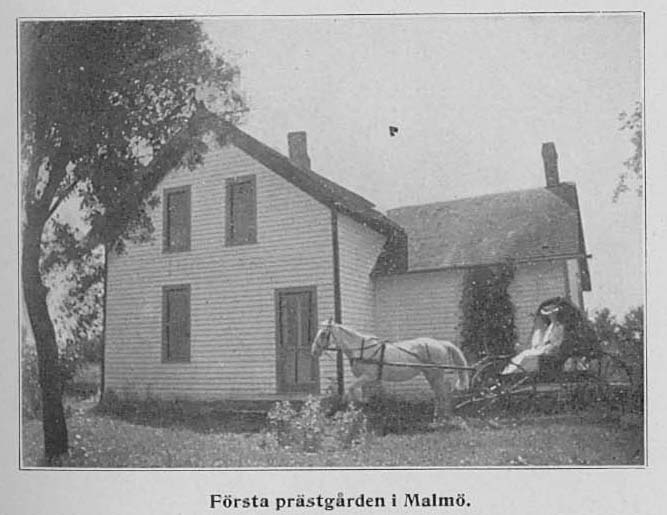
Modern conveyance circa 1900
Each of the three S.G. Larson churches took its name from the post office nearest by: Edensburg, Swedeburg, and Alma. The coming of the railroads caused Edensburg to relocate to Malmo and Alma to Mead, but retaining their earlier names. Later, Saunders County churchman Fredrik Franson counselled churches to be independent; to join no synod, and to take only the name of their local post office. We return now to the Anderson account:
" The Swedish families came by train to Council Bluffs, IA., and here they hired a team for $50 and loaded the wagon with their belongings; the men, women and children, in all six families, were forced to walk. They followed the Missouri River down the Iowa side until opposite Plattsmouth, then ferried across and came to Ashland, fording Salt Creek and Saline Ford. It was the month of March and the water was very icy, so they decided that all should ride across. Reaching the center of the stream the wheels of the wagon became mired and there they stuck. The men finally unhooked the team and went into Ashland, where there were but a few houses at that time, and procured another wagon to haul the people from the center of the creek. They went to Preacher Larson's dugout in Wahoo Precinct, located on the site of his later home, and the families were housed there while they were building their own dugouts.
The first year Mrs. Anderson hired two acres broken and she and her son planted, it to sod corn with spade and hoe. It grew excellently and was considered good corn, but every morning they had to get up early and chase from ten to twenty antelopes and many prairie chickens from the field. C. J. Anderson recalled the first trip to Wahoo, with his mother, his brother Oscar, and a cousin, Hulda Anderson, afterwards Mrs. Martin Berggren. They walked to town, carrying an old-fashioned basket filled with butter and eggs. Jim Lee had a little store in the town at that time, about 12 by 16 feet in size, and here they did their trading. Butter and eggs were high and coffee and sugar were equally so, so there was not much produce to carry back home. The mother bought two cows from Mr. Madison of Cass County, also three pigs in Ashland; an uncle wheeled the porkers sixteen miles in a wheelbarrow. When they were deposited at home it was found that there was no lumber with which to build a pen, so a hole was dug in the ground and this answered the same purpose. Mrs. Anderson made several trips to Ashland, walking, carrying her eggs and butter and returning with a sack of flour across her shoulders."
It is a stretch for the imagination to picture a time before automobiles, highways, and even railroads!
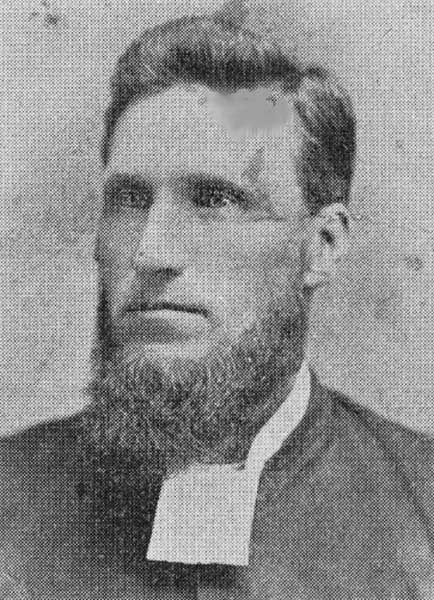
A Saintly Edensburg lay pastor, Nils Nordling
Nils Nordling is the first permanent pastor at Edensburg. He is a lay pastor who in spite of having no formal training is ordained by Augustana. He seems to conform to the type of conventicle leadership known to the revival people. The first Edensburg church seems to lie somewhere between the style of a church building and a mission house. Sandahl reports childhood memories of Nordling's earnestness and does not hesitate to call him a saint.
Andrew Hallner aspired to study law and could navigate the English language. He enjoyed the confidence of S.G. Larson and was delegated to preach by him. When the rule excluding lay preachers from Augustana pulpits came to be enforced, the conventicle-style meetings such as those held by Isaacson took on a new character. They now became the nucleus for new independent congregations, and Hallner did not hesitate to provide leadership in chartering and providing constituting documents...in Swedeburg, Mead, Malmo, Omaha and other places. At Malmo, the new congregation built its Bethesda church to the north and joined the Swedish Evangelical Lutheran Mission Synod.
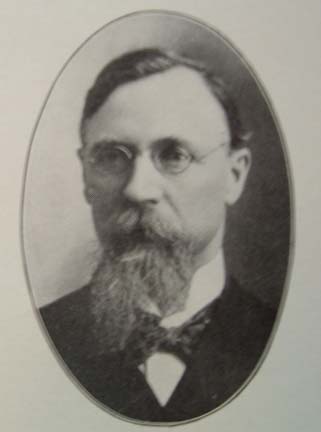 _
_
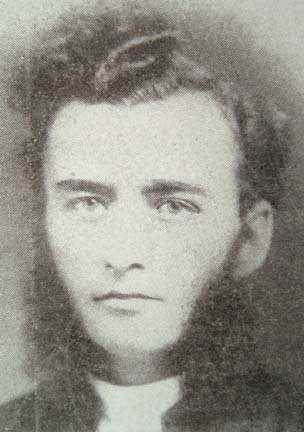
Augustana expatriots Hallner and Sweders
The sad record is told by the lists of families divided in these events. Sandahl speaks poignantly of the tears shed by the aging S.G. Larson over these days. (this event took place when Larson was serving his last pastorate at Imanuel in Council Bluffs; by coincidence we worshipped there on the very day of our Malmo visit) The days which promised unity descended into rivalries in which one side accused the other of being "separatists", even "methodists" or "baptists", while the other rejoined by charging a return to the worldliness of the state church, led by "gloved and perfumed priests."
The next pastor at Malmo Bethesda was A.N. Sweders. His course is traced from Immanual Omaha to Swede Home in Polk County, where he is censured by Kansas authorities for attempting the regenerate membership idea. At Boone, Iowa, he is defrocked for the same offense, but not before transforming the Augustana congregation into a Free Mission body. Sweders like Hallner, served all three Saunders Mission churches. In the Bethesda history we may see the rare example of a free Mission pastor who subscribed to the unaltered Augsburg Confession!
To return to Edensburg church, the next pastor called is Rev. J.P. Nyquist. He was a professor in Sweden and is soon seen in the company of Fogelstrom from Omaha assaying the prospects for a school in Saunders County. Luther College would be the ultimate outcome of these designs. Sandahl has this astonishing thing to say: "He was an educater from Sweden, and for five years he had been president of a school in Minnesota. It is said that some of the brethren even had him in mind as the head of the proposed school...The writer knows for certain that Nyquist was discarded for the position by the leading pastors on account of his ultra-Swedish ways, which had made him a misfit as president of Gustavus Adolphus College." What Sandahl means by his cryptic "ultra-Swedish ways" baffles me.
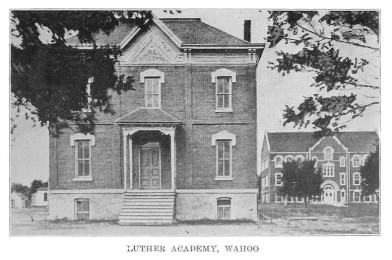
A Swedish achievement in Wahoo: Luther Acadamy
In any case, Nyquist was not a well man; he succombed in 1886 after four years at Malmo, having witnessed the organizational meeting of the Nebraska Conference of Augustana there in the year of his death. His nephew Alfred lived at Wausa and other nephews Victor and Theodore were Mission pastors. The roster of pastors at First Swedish Baptist in Omaha lists a P.J. Nyquist, with the note "luterska prast". Most interesting.
We now have occasion to mention the county seat of Saunders County, the city of Wahoo. Though no prominent early Swedish church was there, it was the center of government and the point of convergence for three railroad systems which crossed there. When these railroads were built they impacted each of our church stories. At Alma, to the east, the new Lutheran church and a Mission church were built in the new railroad station town of Mead; at Swedeburg, to the south, a new Mission church was built "in town", and to the west, the new Lutheran and Mission churches relocated even closer together in Malmo. (Weston, too, should be mentioned to the southwest) A single Wahoo depot is preserved at the Wahoo museum, and is the subject of a book by James Reisdorf, a railroad writer with whom we are acquainted.

Edensburg pastor and Nebraska missionary O.A. Johnson
In Malmo the task of relocation fell to the next Edensburg pastor, O.A. Johnson. Johnson was a homesteader from Polk County who fit the description of lay mission worker. His ultimate ordination by the Augustana officials involved the waiver of educational requirements,as had Nordlings earlier. Sandahl credits him with great "energy and diplomacy" in effecting the relocation of Edensburg from country to town after coming there in 1890. In about 1915, a newer, larger edifice was built. Johnson's mission work took him to farflung Nebraska locales. He lived in Stromsburg for a time, served in Bristow (where my family retains memories of his family) and at the end of his life was quartered at Bethpage, Axtell.
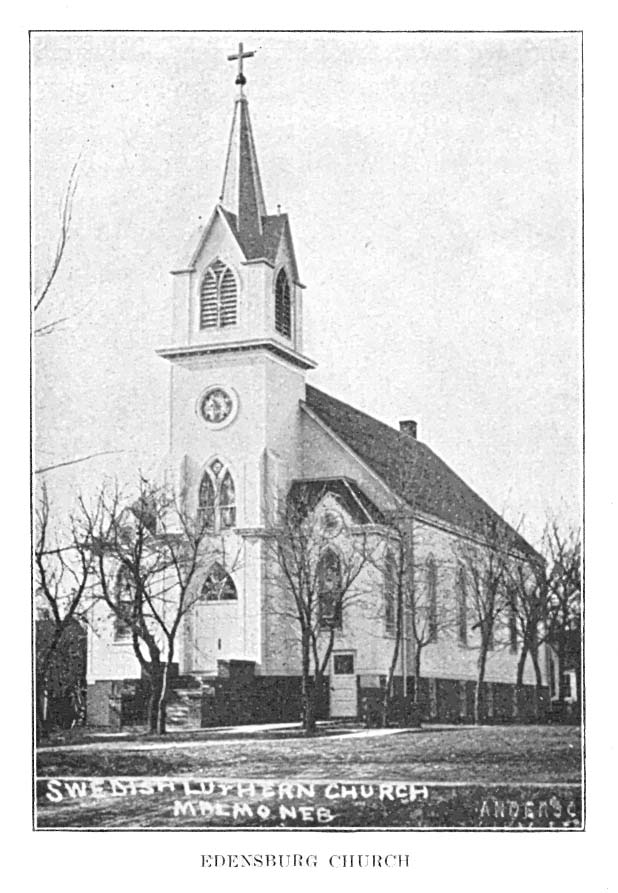
The Edensburg church in Malmo
Following Sweders at Bethesda in 1881 was Gören Norsen, described as a "poet and singer", who guided the congregation through its transition from the Lutheran Mission Synod into the new Mission Covenant in 1885. It was during this time that the Mission Synod held its annual meeting at Malmo, and the delegation described in David Gustafson's piece made their trip to "spy out the land" in Hamilton County to the west. From that venture came the Mission churches of the Aurora area, where Norsen was to spend his career. In company with the leaders shown below were land agents Hallgren and Rylander, who worked in connection with them to bring immigrants to Nebraska. They strategically provided complementary steamship tickets and tour guidance to Waldenström and Princell among others (Gustafson).
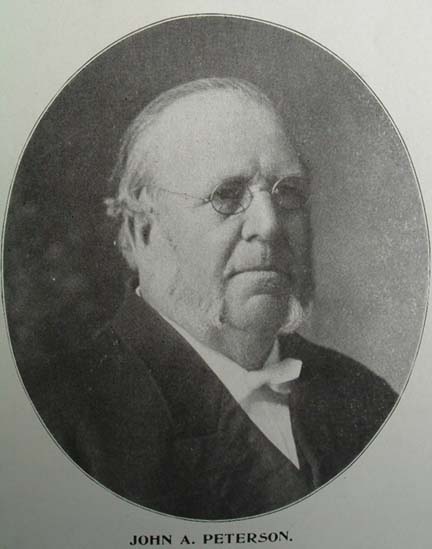 _
_
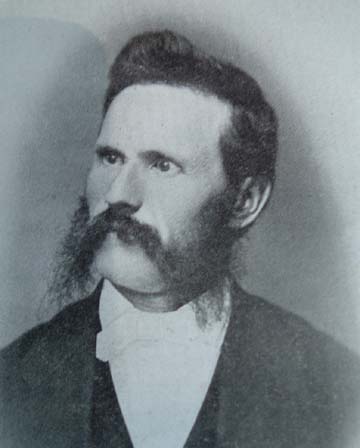 _
_
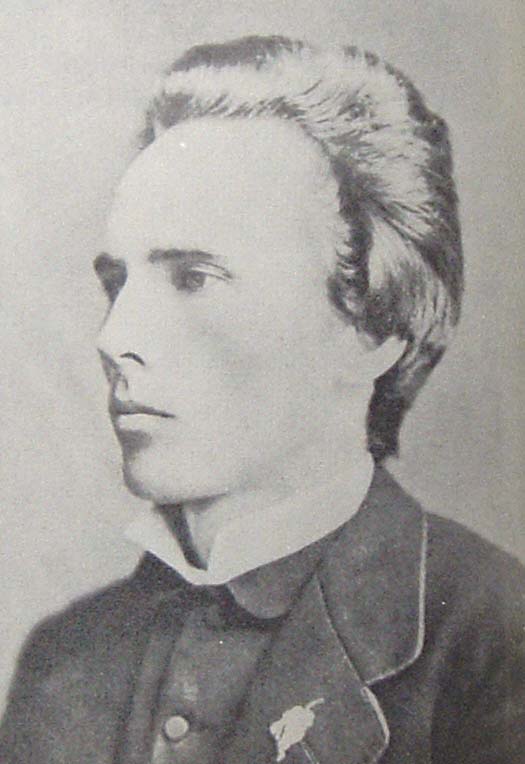
John Peterson, Gören Norsen and E.A. Skogsberg:
they went from the 1878 annual meeting to "spy out" Hamilton County
Next came pastors Lindell, Lindeman and in 1904, K.A. Isacson, the latter being the builder who carried out Bethesda's move from the country to the town. Bethesda's historian does not hesitate to describe their new $10,000 edifice as "one of the finest".

Bethesda
For a brief time in 1888-89, Pastor Adolph A. Magnusson served in Malmo. This was quite a coincidence, because we began the day of our trip to Malmo attending services at Imanuel Lutheran church in Council Bluffs, where Magnusson had also served in 1901-02. An even greater and almost unbelievable coincidence is that he served the Mission church in Princeton, Illinois, from 1883-86, where we spent our internship in 1968!! Now for a provocative question to the reader. Since he served the Mission church in Princeton and the Lutheran church in Council Bluffs, which of the two Malmo churches did he serve? Answer: the Mission church, but he was on his way back to his Augustana Lutheran roots.
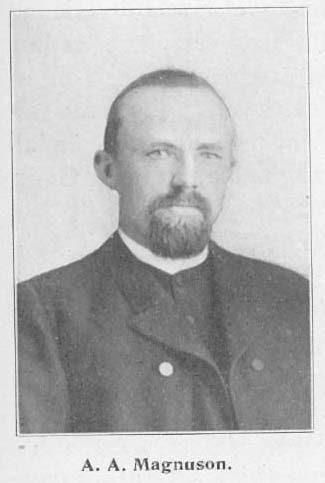
The Man of the Day
Circa 1916 was the zenith of Malmo's population according to recent reckoning, perhaps 400 persons, with the greater part of the two church's membership living on surrounding farms. Today the edifices described in the community's early history stand pretty much as they did then, as survivors in an out-of-the-way artifact of history.
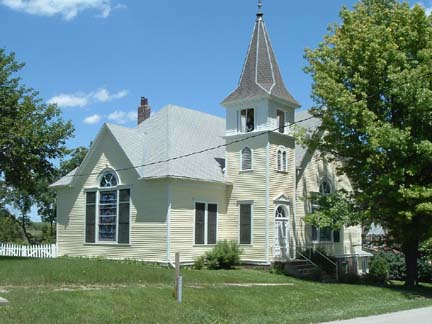
Malmo Bethesda Mission church; a private dwelling today
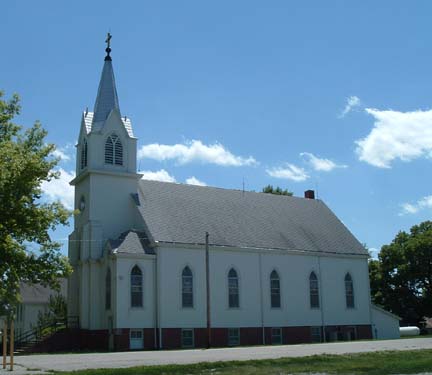
Malmo Edensburg Lutheran today